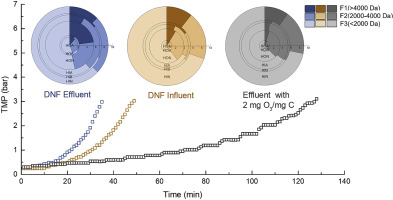当前位置:
X-MOL 学术
›
Water Res.
›
论文详情
Our official English website, www.x-mol.net, welcomes your feedback! (Note: you will need to create a separate account there.)
Membrane fouling potential of the denitrification filter effluent and the control mechanism by ozonation in the process of wastewater reclamation.
Water Research ( IF 12.8 ) Pub Date : 2020-02-06 , DOI: 10.1016/j.watres.2020.115591 Yuan Bai 1 , Yin-Hu Wu 1 , Yun-Hong Wang 1 , Xin Tong 1 , Xue-Hao Zhao 1 , Nozomu Ikuno 2 , Hong-Ying Hu 3
Water Research ( IF 12.8 ) Pub Date : 2020-02-06 , DOI: 10.1016/j.watres.2020.115591 Yuan Bai 1 , Yin-Hu Wu 1 , Yun-Hong Wang 1 , Xin Tong 1 , Xue-Hao Zhao 1 , Nozomu Ikuno 2 , Hong-Ying Hu 3
Affiliation

|
A process of denitrification filter (DNF) coupled with ultrafiltration (UF) and ozonation (DNF-UF-O3) has been widely applied to advanced nitrogen removal for wastewater reclamation. Despite of the effective removal of nitrogen by DNF, the influence of DNF stage on the operation of UF was still unclear. In this study, a laboratory filtration system was used to investigate the membrane fouling potential of DNF effluent and the fouling control of ozonation. The membrane fouling potential was proved to be increased significantly after DNF stage and alleviated with ozonation treatment. With the help of UV-vis, fluorescence spectroscopy, scanning electron microscopy (SEM) and molecular weight (MW) analysis, the change of DOM component characteristics was proved to be in accordance with the change of fouling potential. The water samples were further fractionated into six hydrophobic/hydrophilic acidic/basic/neutral fractions, among which hydrophobic acids (HOA) and hydrophobic neutrals (HON) dominated the membrane fouling potential of DNF effluent. Detailed study of each fraction revealed that higher MW components in HOA and HON played a crucial role in the fouling of UF membrane. The dominant component of membrane fouling could be degraded and removed by ozonation, and therefore significant fouling alleviation was achieved. These results indicated that in the process of wastewater reclamation, besides conventional water quality indexes, more detailed water features should also be taken into consideration to optimize the whole process. Moreover, the control effects by ozonation could be monitored simply according to the change of specific UV absorbance (SUVA) and fluorescence intensity as surrogates in engineering applications. According to these results, a modified DNF-O3-UF process with O3 dosage of 3 mg/L was proposed simply by reversing the sequence of UF and O3 with no more infrastructure. This modified DNF-O3-UF process was expected to enlarge the produce capacity of reclaimed water with much lower electricity costs and chemical consumption.
中文翻译:

废水再生利用过程中反硝化滤池废水的膜污染潜力及臭氧控制机制。
反硝化过滤器(DNF)与超滤(UF)和臭氧化(DNF-UF-O3)结合的工艺已广泛应用于废水回收中的高级脱氮。尽管通过DNF有效去除了氮,但DNF阶段对超滤操作的影响仍不清楚。在这项研究中,实验室过滤系统用于研究DNF流出物的膜结垢潜力和臭氧化的结垢控制。事实证明,在DNF阶段之后,膜污染的可能性显着增加,并通过臭氧处理得以缓解。借助于紫外可见,荧光光谱,扫描电子显微镜(SEM)和分子量(MW)分析,证明了DOM组分特性的变化与结垢电位的变化一致。将水样品进一步分馏为六个疏水/亲水酸性/碱性/中性馏分,其中疏水酸(HOA)和疏水中性(HON)主导了DNF废水的膜污染潜力。对每个部分的详细研究表明,HOA和HON中较高的MW组分在超滤膜结垢中起关键作用。膜污染的主要成分可以通过臭氧化降解和去除,因此可以显着减轻污染。这些结果表明,在废水回收过程中,除了常规的水质指标外,还应考虑更详细的水特征以优化整个过程。此外,臭氧化的控制效果可以简单地根据工程应用中的替代紫外线吸收率(SUVA)和荧光强度的变化进行监测。根据这些结果,提出了一种改进的DNF-O3-UF工艺,该工艺的O3剂量为3 mg / L,仅通过颠倒UF和O3的顺序即可,无需更多基础设施。预期这种改进的DNF-O3-UF工艺可提高再生水的生产能力,而用电成本和化学消耗却低得多。
更新日期:2020-02-07
中文翻译:

废水再生利用过程中反硝化滤池废水的膜污染潜力及臭氧控制机制。
反硝化过滤器(DNF)与超滤(UF)和臭氧化(DNF-UF-O3)结合的工艺已广泛应用于废水回收中的高级脱氮。尽管通过DNF有效去除了氮,但DNF阶段对超滤操作的影响仍不清楚。在这项研究中,实验室过滤系统用于研究DNF流出物的膜结垢潜力和臭氧化的结垢控制。事实证明,在DNF阶段之后,膜污染的可能性显着增加,并通过臭氧处理得以缓解。借助于紫外可见,荧光光谱,扫描电子显微镜(SEM)和分子量(MW)分析,证明了DOM组分特性的变化与结垢电位的变化一致。将水样品进一步分馏为六个疏水/亲水酸性/碱性/中性馏分,其中疏水酸(HOA)和疏水中性(HON)主导了DNF废水的膜污染潜力。对每个部分的详细研究表明,HOA和HON中较高的MW组分在超滤膜结垢中起关键作用。膜污染的主要成分可以通过臭氧化降解和去除,因此可以显着减轻污染。这些结果表明,在废水回收过程中,除了常规的水质指标外,还应考虑更详细的水特征以优化整个过程。此外,臭氧化的控制效果可以简单地根据工程应用中的替代紫外线吸收率(SUVA)和荧光强度的变化进行监测。根据这些结果,提出了一种改进的DNF-O3-UF工艺,该工艺的O3剂量为3 mg / L,仅通过颠倒UF和O3的顺序即可,无需更多基础设施。预期这种改进的DNF-O3-UF工艺可提高再生水的生产能力,而用电成本和化学消耗却低得多。


























 京公网安备 11010802027423号
京公网安备 11010802027423号